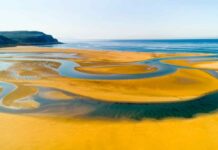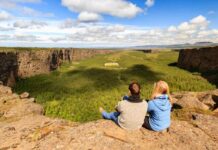So you want to go camping in Iceland but don’t have the first clue about how to do it? Do you envision yourself sleeping under the Northern Lights and waking up to watch the sunrise over a fjord? Are you afraid of having that dream dashed by a farmer chasing you off his land for trespassing? That’s where knowing Iceland camping law comes in handy.

Iceland Camping Law
In recent years the government has passed restrictions due to the influx of travelers that visit. Although this boom in tourism might be helping the economy, tourists tend to leave a carbon footprint wherever they go.
Sustainable tourism has become a must. To better protect the environment in South Iceland, it is now only legal to camp inside designated campsites. This restriction applies for tent camping as well as campervans, caravans or similar vehicles though this can differ elsewhere.
Written consent is necessary in inhabited areas in the rest of the country, which might be easy enough to obtain. The landowners probably live at the farm just up the field so knock on their door at your own risk. Some might be happy to help campers for a night as long as they promise to clean up after themselves. No one likes a messy houseguest and to natives, the countryside is as much their home as their living rooms.
Wild Camping Rules in Iceland
When it comes to a trip around Iceland, how you go is more important than where you go. Since 2017, all travelers in South Iceland are subject to a fine if caught residing outside regulated campsites. This includes private property and roadsides, so no pulling over for the night unless at a designated camping site.
Even travelers on foot with more than three tents require explicit consent from the landowner to set up camp anywhere. Legally, all travelers are obligated to stay in a campsite if there is one in the area or the county. Considering there are more than two hundred such sites located around the island nation, these can be hard to avoid.
Still, wild camping in Iceland is still an option for campers that must rebel against the system as long as they:
- Camp on uncultivated lands that are not for private or public use
- Have less than three tents
- Stay only one night
- Stay in a municipality or county that doesn’t outright forbid wild camping (which most do)
Basically, wild camping in Iceland is possible except in South Iceland, but is highly discouraged by local authorities and natives. Unless you really want to stay in the Highlands, it’s best to stick to designated campsites in Iceland. There’s generally plenty of space for everyone.
Designated Campsites
The Icelandic countryside is littered with campsites, about the only things the locals expect to be left with when campers depart. Preserving the environment is of the utmost importance, which is why campsite regulations have been constantly added over the years. Such campsites typically cost between $10-15USD per person but that’s chump change compared to the price of a hotel stay. Traveling by campervan is by far the most economic option and most campgrounds come equipped with copious facilities. These usually include electricity, toilets, hot and cold shower facilities, washing machines and waste disposal for mobile homes. Some campsites even provide Wi-Fi for a small fee like in the case of Egilsstaðir.

Travellers should make sure to research the advantages of certain campsites over others as not all are built the same. A little bit of forethought can be the difference between a great camping experience and a mediocre one. Many campsites are actually cordoned-off fields with absolutely no amenities except the scenery and most operate without a reservation system. This is not to say that there won’t be room for everyone as they do normally have a reception area. This means regulated arrival and departure times so prudent campers are likely to snag a spot if they arrive early.
Travelers should also keep in mind that many campsites typically close in the fall, starting in mid-September. Since the majority of Iceland’s visitors flood the island during summer, this means limited accommodation in winter. If you’re planning your trip for low-season, look into year-round campsites such as Hamragarðar which has more modern facilities. There’s also Reykjavik, just 3 km (2 miles) away from the city center and Lifsmotun whose town has a swimming pool.
Iceland Freedom to Roam
Like many Nordic countries, visitors have the right to access natural public and private lands for recreational use. However, this is only up to an extent as a result of new regulations enacted to protect the fragile ecosystem.
Nevertheless, campervans are one of the easiest ways of traveling in Iceland. No matter your set of wheels though, make sure to fill your tank at any gas station around the country. This is particularly necessary if you’re going off the beaten trail as there is often no turning back.
Most travelers follow Route 1, also known as Ring Road, a 1,332 km (828-mile) national road inaugurated in 1978. It connects most inhabited areas and famous attractions, and between gaps in civilization lie often-life-saving gas stations. These are usually a mix of cafe, restaurant, retail, hardware store, and community center, rolled into one shop. Most sell fresh produce like real grocery stores and some even sell farming supplies. If there’s an information center in town, it’s also sure to be located there.
Campers should note that many gas stations are self-serve and nearly all require credit cards with PIN numbers. Don’t make the mistake of getting stuck at the store after-hours because of this tiny yet significant detail. North American gas-pumpers should also remark that diesel pumps in Iceland have black handles and ordinary gasoline green.

There will be numerous sights on your journey around the beautiful country, each more breath-taking than the last. Many are situated close to official campgrounds such as the Blue Lagoon near Grindavík or Vatnajökull Glacier near Skaftafell. You can even roam in national parks with designated campsites such as Ásbyrgi AKA the Shelter of the Gods. An adventure awaits you around every bend of the roads in Iceland.
Camping Made Convenient
For a truly magical experience when you visit Iceland, consider taking a self-guided tour of Ring Road and beyond. There are several tourist companies that offer deals on transportation so renting a campervan or bigger is easier than ever. You can alternatively rent a car but it’d be a good idea not to jeopardize comfort for a few dollars. Some agencies even provide 4×4 vehicles with built-in GPS and chargers, camping equipment and a campsite parking pass included.
Summer is undoubtedly the best time to travel as parts of Ring Road close due to inclement weather in winter. This means missing the Northern Lights unless you just have to scratch them off your bucket-list and see them firsthand. For those planning to tough out the oft-temperamental weather, I’d highly recommend getting a campervan. Last thing you want is to be cooped up in a tiny space because the roads are blocked with snow.
If you don’t need the space and crave companionship, why not bring your four-legged best friend along? Many campsites will let your furry companion share your sleeping bag as long as he’s a good boy. Most rental agencies don’t explicitly forbid it, either. Feel the call of the wild and howl at the Northern Lights together if that’s what your heart desires. I’m sure he’ll be just as pleased as you.
Final Thoughts About Iceland Camping Laws
The landscape of wild camping in Iceland has changed drastically over the years but only for the better. Government ordinances have been implemented to protect the environment with good measure but that doesn’t mean campsites are limited. What you’ll save on accommodation you’ll certainly need to pay what might perhaps be a shocking gas bill. Gas is honestly a bit expensive in Iceland with the fuel costing 170ISK/L ($7-8 a gallon) even among competitive brands like Costco.
Don’t scrimp on filling your tank since you’re going to need enough mileage to get around. The best campsites tend to be just down the road from some of the best attractions. Many offer affordable rates and unbeatable locations right on Ring Road close to another with the promise of endless sights. Why not jump behind the wheel and hit the Icelandic trail today? The fjords are calling you.



































